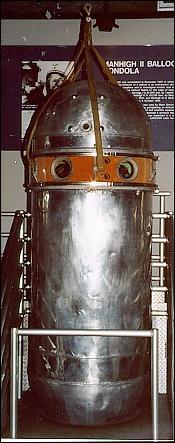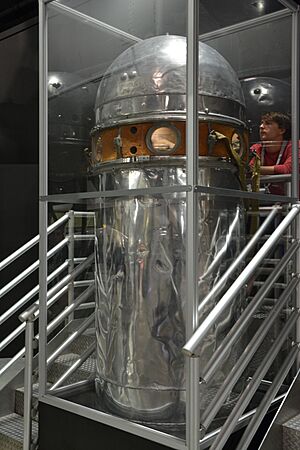Project Manhigh facts for kids
Project Manhigh was an exciting project from the 1950s. It was a time before humans traveled into space in rockets. This project used giant balloons to send brave pilots very high up. They went into the middle layer of Earth's atmosphere called the stratosphere. The main goal was to learn how space conditions might affect people. It also helped prepare for future space travel. The United States Air Force ran this project from 1955 to 1958.
Contents
Exploring the Edge of Space
This project began in December 1955. Scientists wanted to study tiny particles from space called cosmic rays. They needed to know how these rays might affect humans. This research was important for future space missions. The project used special capsules carried by huge balloons. These capsules were like small spacecraft. They protected the pilots as they climbed to incredible heights.
Brave Pilots and Their Flights
Three main balloon flights took place during Project Manhigh. Each flight pushed the boundaries of human exploration.
- Manhigh I: On June 2, 1957, Captain Joseph W. Kittinger made the first flight. He reached an amazing height of about 29,500 meters (96,784 feet). The flight had to end early because of a small equipment issue. But Captain Kittinger still set a new altitude record!
- Manhigh II: Major David G. Simons flew Manhigh II on August 19-20, 1957. This was a very long flight, lasting 32 hours. He went even higher, reaching about 30,942 meters. Major Simons performed 25 different experiments during his journey. His incredible adventure even put him on the cover of Life magazine! The capsule and its equipment weighed about 748 kilograms (1,650 pounds). At its highest point, the balloon was huge, about 60 meters (200 feet) wide. It held over 85,000 cubic meters of gas.
- Manhigh III: Lieutenant Clifton M. McClure completed the last flight on October 8, 1958. He reached an altitude of about 29,900 meters. These flights gathered important information for future space explorers.
Paving the Way for Astronauts
The pilots chosen for the Manhigh project went through tough physical and mental tests. These tests were very important. They later became the standard way to select astronauts. This included the brave men of Project Mercury. Project Mercury was America's first program to send humans into orbit around Earth. So, Project Manhigh helped prepare the way for space travel.
Earlier High-Flying Adventures
Before Project Manhigh, other brave explorers also used balloons to reach high altitudes.
- In 1931, Swiss physicist Auguste Piccard and Paul Kipfer reached about 15,785 meters.
- The USSR-1 balloon, flown by Georgy Prokofiev, reached about 18,500 meters in 1933.
- The Osoaviakhim-1 balloon went up to about 22,000 meters in 1934.
- The Explorer II balloon reached about 22,066 meters in 1935.
These earlier flights showed what was possible. Project Manhigh built on their achievements.
See also
 In Spanish: Proyecto Manhigh para niños
In Spanish: Proyecto Manhigh para niños
- John Stapp
- Project Excelsior, follow-on flights in 1959 and 1960
- Project Adam, a contemporary plan using Manhigh hardware by the United States Army
- Flight altitude record



